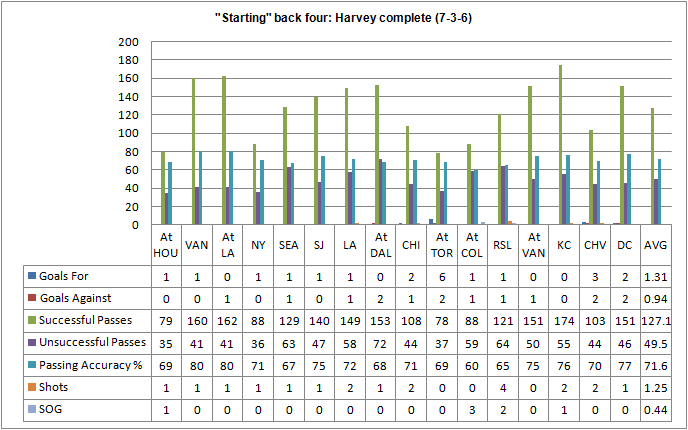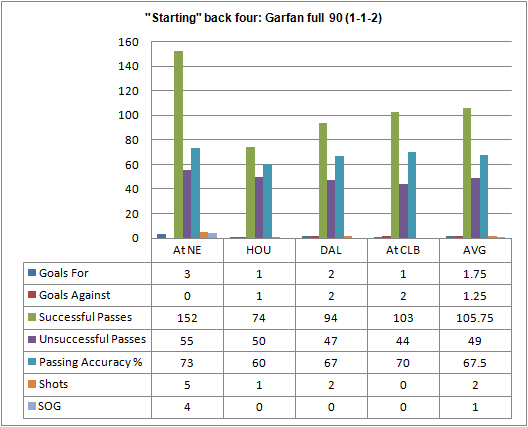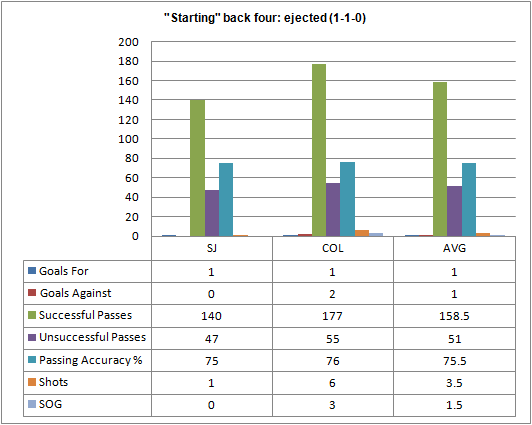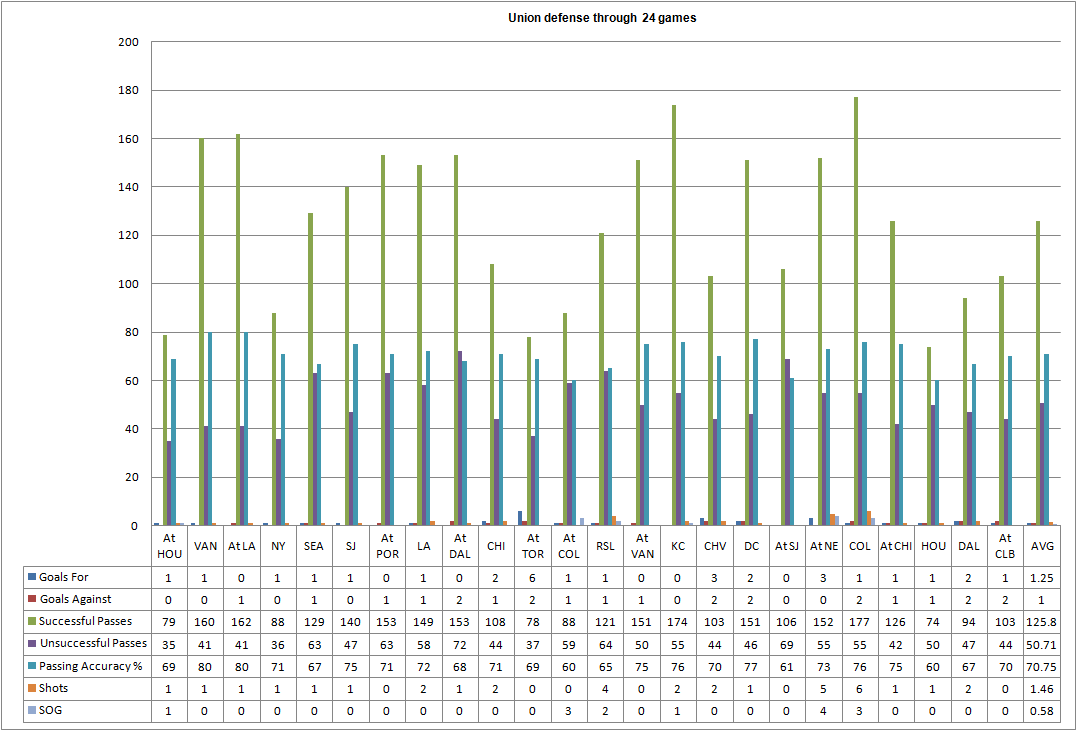Photo: Nicolae Stoian
The question of consistent selection with the Union starting lineups has vexed the team’s supporters from the start of the season. Except for the defensive starters. They have been comfortingly predictable, apart from three occasions involving illness or suspension—one of which happened to overlap with a transfer that came out of nowhere and resulted in a new back four.
With Carlos Valdes unavailable against Real Salt Lake due to a one game suspension from accumulated yellow cards, the team and its supporters once again find themselves in one of those thankfully rare but nevertheless fraught occasions when just who will start in the back four is the question of the moment.
The starting back four
Over the first 15 games of the season, the Union defense contributed to five shutouts, a shutout percentage of .333 with the longest break between shutouts being four games. Over the last nine games, the Union has two shutouts for a shutout percentage of .222 with no shutouts in the last five games. Over the same time periods, the Union allowed 12 goals over the first 15 games, or 0.8 goals per game. Over the last nine games, the Union has also allowed 12 goals, or 1.3 goals per game.
Broadly speaking, the Union has had two starting back lines: the Jordan Harvey-Carlos Valdes-Danny Califf-Sheanon Williams line that started the season and the Gabriel Farfan-Valdes-Califf-Williams line that began with Harvey’s transfer to Vancouver. These two starting back fours can be further broken down into three more groups: the starting back four with Harvey and with substitutions; the starting back four with Gabriel and one or two fill-in defenders; a Harvey or Garfan back four in which a starting defender is ejected. The chart below lists the
Union defense’s numbers in seven categories (click on the image of all of the charts in this post to see them in full size): goals for and against the Union in each match; the number of successful passes, unsuccessful passes and passing accuracy percentage for the defensive starters; and the shots and shots on goal registered by the defensive starters. These numbers will be used as a benchmark when we look at each of the various back four combinations.
Starting back four with Jordan Harvey
 Jordan Harvey played 16 matches with the Union in 2011, recording nine complete games while being subbed out in six games and ejected once. The overall record for the Union over those 16 games was 7–3–6. When Harvey played the full 90, the Union’s record was 3–2–4. When he was subbed out their record was 3–1–2 and the Union won the game from which he was ejected.
Jordan Harvey played 16 matches with the Union in 2011, recording nine complete games while being subbed out in six games and ejected once. The overall record for the Union over those 16 games was 7–3–6. When Harvey played the full 90, the Union’s record was 3–2–4. When he was subbed out their record was 3–1–2 and the Union won the game from which he was ejected.
The Union had a slightly better goals for average of 1.33 when Harvey played the full 90 compared to the season average of 1.25, while the goals against average is the same at 1. The team’s overall number of successful passes average of 125.8 is higher than the 122.4 average when Harvey had a complete game. However, the average for the number of unsuccessful passes overall is slightly higher at 50.71 than the average of 49.3 with Harvey. The passing accuracy percentage is nearly equal, the 70.78 percent average when Harvey played a complete game being .03 percent better than the 70.75 percent overall. The average for production of shots overall from the defense is nearly double at 1.46 compared to the 0.89 average when Harvey completed a game. The overall average for shots on goal from the defense, however, is nearly equal at 0.58 compared to 0.56 when Harvey went the distance.
 Starting back four with Harvey: substitutions
Starting back four with Harvey: substitutions
The Union have substituted a defender seven times this season, with Harvey being subbed out six times and Sheanon Williams subbed out once (in the loss in LA).
Four times a defender was subbed out when the Union were tied with their opponent. Two times this happened at home when there was no score (Vancouver, Chicago) and those games ended as Union wins. Twice a defender was subbed out when there was a 1–1 draw (RSL, Chivas USA) at home and those games ended in a draw and a win. The Union has made a defensive substitution three times when they were trailing 1–0, once at home for a draw (LA) and twice on the road for 1–0 losses (LA, Vancouver). So, while subbing out a defender has given a successful result when the Union has been tied, it has been much less successful when the Union is trailing, particularly on the road.
It comes as no surprise that the Union’s goals for average is lower in games in which a defender was substituted; a defender was switched out precisely because the Union needed to score goals. Nevertheless, and this is indicative of the Union’s offensive woes in general, the goals against average is the same as both the Union’s overall season average and the average when Harvey played the full 90 minutes. Interestingly, the successful pass average for the defense is significantly higher at 136.4 while the unsuccessful pass average is marginally lower at 48.86, which results a higher passing accuracy average of 73.29 percent. When a defender has been substituted, the average for shots is 1.71, higher than the overall season average and the average for the back line with Harvey playing a complete game. The average for shots on goal is the lower than the season average and when the Harvey backline is unsubstituted at 0.29.
Starting back four with Harvey complete
When looking at the averages from the previous categories and then comparing them to the averages for the 16 games in which Harvey had an appearance, the successful passes average of 127.1 is the third highest of the group but above the season average of 128.8. The average of unsuccessful passes is 49.5, just below the season
 average of 50.71. The passing accuracy percentage of 71.6 percent is above the season average of 70.75 percent while the shots average of 1.25 is third below the season average of 1.46. The shots on goal average of 0.44 is third behind the overall average of 0.58.
average of 50.71. The passing accuracy percentage of 71.6 percent is above the season average of 70.75 percent while the shots average of 1.25 is third below the season average of 1.46. The shots on goal average of 0.44 is third behind the overall average of 0.58.
Significantly, the goals for average over Harvey’s 16 games of 1.31 is higher than the overall season average of 1.25, this despite three of Harvey’s last six games with the Union corresponding with Carlos Ruiz being away on international duty and the scoreless draw with KC upon his return. Most important of all, the goals allowed average of .94 is lower than the season average of 1.
Starting back four with Gabriel Farfan
With the transfer of Jordan Harvey, Gabriel Farfan, a natural midfielder, was tapped to be the Union’s new left back. He had already been so deputized for the 1–0 away loss to Portland when Danny Califf’s illness and Jordan Harvey’s red card suspension resulted in the makeshift backline of Garfan-Valdes-Williams-Marfan—where was subbed out at the start of the second half with the Union 1–0 down. When Garfan became the new starting left back the Union’s starting left back after Harvey’s departure, his first three games would also be on the road. All told, five of Garfan’s eight starts as a defender have been on the road for a 1–3–4 record overall. He also has two road starts as a midfielder, the win against Toronto, in which he scored the opening goal, and in the draw with Colorado.
 Of Garfan’s eight starts as a defender, four have been with the new standard back four of Garfan-Valdes-Califf-Williams. Two of those starts have been on the road for an overall record of 1–1–2. While the goals for average of 1.75 when Garfan plays a complete game as part of the standard back four is higher than the overall season average, the goals allowed average of 1.13 is also higher. The averages for successful passes, unsuccessful passes and passing accuracy percentage are also all poorer than the season averages for those categories with the successful passes average of 105.75 being a full 20 passes lower and the passing accuracy percentage of 67.5 percent being three percent lower.
Of Garfan’s eight starts as a defender, four have been with the new standard back four of Garfan-Valdes-Califf-Williams. Two of those starts have been on the road for an overall record of 1–1–2. While the goals for average of 1.75 when Garfan plays a complete game as part of the standard back four is higher than the overall season average, the goals allowed average of 1.13 is also higher. The averages for successful passes, unsuccessful passes and passing accuracy percentage are also all poorer than the season averages for those categories with the successful passes average of 105.75 being a full 20 passes lower and the passing accuracy percentage of 67.5 percent being three percent lower.
Three of Garfan’s starts have involved makeshift back lines. Against Portland, Garfan himself was one of the fill-ins.  His debut as the new starting left back against San Jose away coincided with an illness for Carlos Valdes that saw Stefani Miglioranzi as the replacement center back. And against Chicago away, Sheanon Williams’ absence with a red card suspension saw Michael Farfan in his second start at right back. The Union’s record for these three games is 0–1–3.
His debut as the new starting left back against San Jose away coincided with an illness for Carlos Valdes that saw Stefani Miglioranzi as the replacement center back. And against Chicago away, Sheanon Williams’ absence with a red card suspension saw Michael Farfan in his second start at right back. The Union’s record for these three games is 0–1–3.
The averages for these games are unsurprisingly mixed given the makeshift nature of the defense and the results. While the goals allowed average is the lowest of any of the categories at 0.67, so to is the 0.33 average for goals scored. The successful passes average 128.33 for the makeshift defense is higher than the season average but so to is the average for unsuccessful passes and the passing accuracy percentage is lower. The averages for shots is a bare 0.33 while none of the defenders in these three games recorded a shot on goal.
Starting back four with Garfan complete
When looking at the overall averages for games that Garfan has started in (he has only been subbed out once), the defense’s numbers are poorer than the season averages—and the overall averages for games in which Harvey featured in the back four—across the board.
The Union’s goals for average with the Garfan back line is 1.13 compared to 1.25 for the season and 1.31 for the overall Harvey back line averages. The goals against average of 1.13 is higher than the 1 overall and 0.94 with the Harvey back line. The successful passes average are lower, the unsuccessful passes average is higher and the passing accuracy percentage is lower. The defense does seem to be getting more involved in the offense, however— both the shots average of 1.86 and shots on goal average of .86 are higher than the season average overall and the average for the backline with Harvey—although the bump in the shots on goal average is due to a burst of shots on goal against New England (which resulted in goals for Valdes and Williams) and in frenetic finale of the loss to Colorado.
compared to 1.25 for the season and 1.31 for the overall Harvey back line averages. The goals against average of 1.13 is higher than the 1 overall and 0.94 with the Harvey back line. The successful passes average are lower, the unsuccessful passes average is higher and the passing accuracy percentage is lower. The defense does seem to be getting more involved in the offense, however— both the shots average of 1.86 and shots on goal average of .86 are higher than the season average overall and the average for the backline with Harvey—although the bump in the shots on goal average is due to a burst of shots on goal against New England (which resulted in goals for Valdes and Williams) and in frenetic finale of the loss to Colorado.
Starting back four: Ejected
Both the starting back four with Harvey and the starting back four with Garfan have each seen a player ejected once. Harvey was ejected against San Jose at home and Williams was ejected against Colorado at home. The Union’s record when playing with ten men is 1–1–0.
 Both the goals for and goals against averages are at 1 when a defender has been ejected, 20 percent below the season average for goals for and equal to the season average for goals allowed. Reflecting the increased tempo that occurs when a spirited team such as the Union finds itself a man down, the average for the number of successful passes is nearly 23 passes higher than the season average overall while the number of unsuccessful passes is nearly equal to the season average, resulting in a passing accuracy rate of 75.5 percent. By necessity, the defense must become more involved in the attack when a team is shorthanded and so the shots average is more than double the season average at 3.5 while the shots on goal average is nearly three times the season average.
Both the goals for and goals against averages are at 1 when a defender has been ejected, 20 percent below the season average for goals for and equal to the season average for goals allowed. Reflecting the increased tempo that occurs when a spirited team such as the Union finds itself a man down, the average for the number of successful passes is nearly 23 passes higher than the season average overall while the number of unsuccessful passes is nearly equal to the season average, resulting in a passing accuracy rate of 75.5 percent. By necessity, the defense must become more involved in the attack when a team is shorthanded and so the shots average is more than double the season average at 3.5 while the shots on goal average is nearly three times the season average.
Its been said before, but some teams actually look better when playing with ten men. Of course, if this were really true, the Union would have won both games.
Starting back four with Harvey vs starting back four with Garfan
Is it surprising that the numbers for a backline that includes a converted midfielder playing the majority of his games on the road, and more than a third of his games with a makeshift back line, are not as good as those of a backline that included a journeyman left back? Of course not. Nor can the blame for the current offensive slump be laid at the feet of the post-Harvey backline.
Looking at a head-to-head comparison of Harvey and Garfan’s personal averages for successful passes, unsuccessful passes and passing accuracy, Garfan’s average of 39.3 passes and 72.2 percent passing accuracy is superior to Harvey’s 28.25 successful passes average and 70.6 percent accuracy. Harvey’s 11.9 unsuccessful passes average is better than Garfan’s unsuccessful pass average of 15.
So, what of the trend toward the Union allowing more goals? Of the eight goals scored on the Union with the Garfan backline, how many can you blame on Garfan? Looking over the video of each game, maybe Garfan has some blame for the second Colorado goal, maybe for the first Columbus goal. Maybe.
More likely, the poorer record comes not from any significant responsibility on Garfan’s part or any adjustment problems from his new defensive partners but fatigue on the part of his three back line partners. In the season so far, Valdes, Califf and Williams have only missed one start each due to illness or suspension. All of them have played the full 90 minutes of every league match with the exception of Williams being subbed off in the 73rd minute in LA and when he was ejected in the 64th minute against Colorado at home. Twenty-four league matches, a US Open Cup match that went to PKs and four friendlies in six months takes a toll.
One measure of fatigue can be passing accuracy—as a player becomes less mentally and physically sharp while dealing with the stress of a long season as well as the cumulative physical effect of many games and nagging minor injuries, passing accuracy would understandably decline.
If passing accuracy can be an indicator of fatigue, then looking at the overall averages for the stalwart three of the defense—Valdes, Califf and Williams—fatigue does seem to be apparent. The passing accuracy of Valdes and Califf has declined from the start of the season, as indicated from the top two trend lines in the chart above, while the passing accuracy of Williams hovers around 60 percent. Indeed, the passing accuracy over the last three games is down markedly from the season average. Where as Valdes’ season average is 70.5 percent, over the last three games his average is 54.6 percent. Williams is down from 65.8 percent to 58.7 percent. For Califf the decline in accuracy over the past three games is less pronounced, down from 78.3 percent to 76.3 percent.
With Valdes suspended for the Real Salt Lake game this weekend, Garfan will once again be a part of a makeshift back four. If the past record is any predictor, the best Union fans can hope for is a draw. While Union supporters surely would have preferred Valdes to miss the scheduled New England match, the plus side of its postponement is that everyone got an unexpected week off and Valdes will have an additional weekend off as the Union head into the final ten games of the season. With ten games to play between September 3 and October 20—that’s one game every 4.8 days—the unscheduled rest couldn’t have come at a better time every Union player, defenders and all.




I hope they find a real left back in the off season…and although I appreciate the write up, isnt it a little too early for this analysis? Also I don’t think anybody is blaming the offensive woes on the defense…more like blaming the defensive woes on the defense.
The money that is tied up with Gonzalez not being able to make it out of the reserve squad is really hurting the defensive depth. You have to imagine that if he was able to be put on the field, or the team had that money utilized on other players, the back line would have more rest at this point in the season.